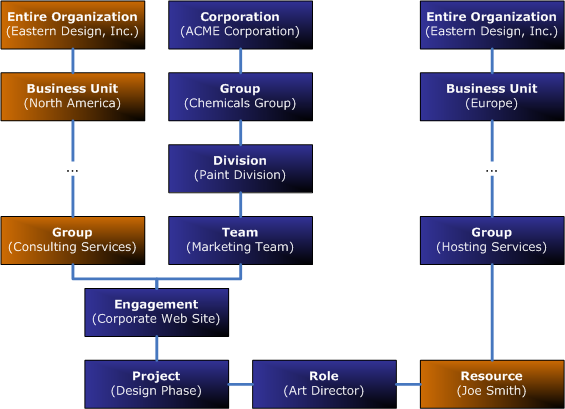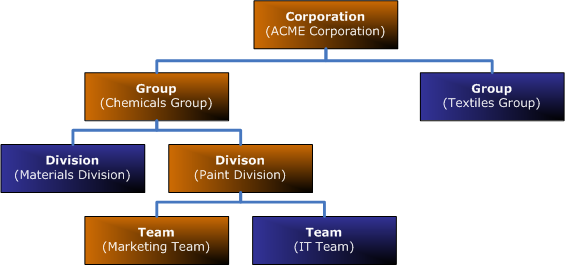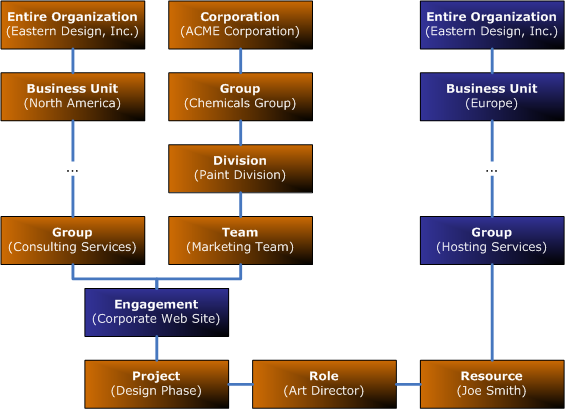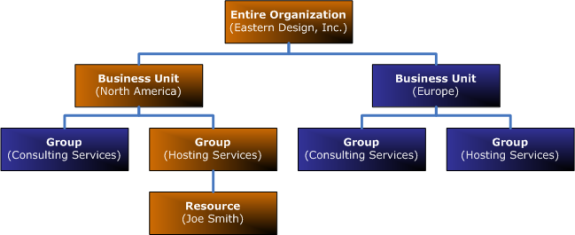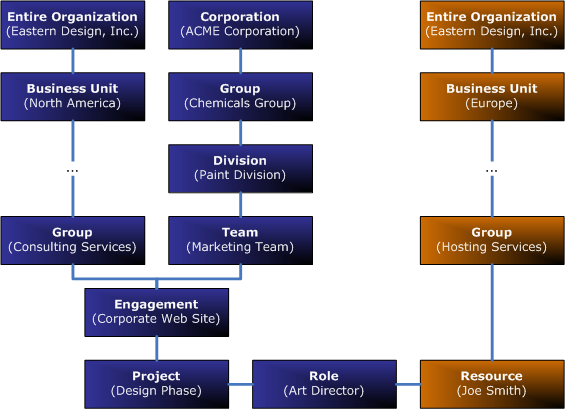Managing Rates
Additional Resources
Topic of the Day: Rate Management Webinar provides an overview of the rate structures in Projector.
This section describes how Projector determines how to set each of the typical rates and revenue types by analyzing rate cards, discounts, and overrides. It discusses how organizations can use Projector to manage rates as well as the process that Projector uses to determine the rate for a particular project, role, rate type, and date combination for each of the rate/revenue types:
Standard Rates
Overview of Standard Rates
As mentioned previously, standard rates represent the current, published, non-discounted rate card of a particular cost center and express the full earning potential of a project, resource, or unit of work. Each cost center also has one and only one standard rate card that applies for all projects within that cost center, no matter when the project was initiated.
Managing Standard Rates in Projector
Standard rates can differ from cost center to cost center to reflect differences in market conditions or for different service offerings. When cost centers are set up so that these differences do not exist, they can inherit their standard rate cards from another cost center. For instance, consider the following organization:
In this example, the North American and European business units may have separate standard rate cards because the common market pricing or base currency is different between the two markets. However, the Consulting Services and Hosting Services groups in each business unit may just be linked to the standard rate cards for their respective business units because standard market pricing of those services not are different enough to have their own distinct rate cards. When the rate cards for the business units are updated (either by changing the rates in the rate cards themselves or by linking the business units with entirely new rate cards), the linked cost centers will adopt the standard rate cards of their parents immediately. Alternatively, the Consulting Services group, the Hosting Services group, or both could be given their own unique standard rate cards if business conditions demand.
Only a single standard rate card can exist for each cost center, so updating which rate card is identified as the cost center's standard rate card will immediately update the standard rate cards for all engagements associated with that cost center. Similarly, if there are child cost centers linked to the cost center whose rate card was updated, all engagements associated with the child cost centers will also be immediately be updated. Rate card linking can be defined only to a single level, so if the Hosting Services group is linked to the North American business unit, another cost center cannot be linked to the Hosting Services group.
Projector's currency conversion functionality enables organizations to manage their standard rate cards in the native currency for each cost center. In the example above, the North American business unit's standard rate cards can be expressed in dollars, while the European business unit's cards can be managed in euros. When financial numbers are calculated that cross currency lines, they are converted into a single currency for aggregation and calculation using foreign exchange rates managed in Projector.
Generally, organizations will prefer to manage standard rates as high up in the cost center rollup as possible to limit the amount of data administration needed and to utilize Projector's inheritance model to link lower level cost centers.
Determining Standard Rates for a Work Unit
Projector determines standard rates by first looking at the resource that actually did the work (or is scheduled to do the work) and determining that resource's actual title (ignoring the Base Rates on Specific Title setting) at the time the work is completed. The system then walks up the cost center structure of the engagement's cost center until it finds a standard rate card. Finally, it uses the resource's title and the standard rate card to determine the current standard rate to use. For standard rates, there are no title-based or explicit rate overrides.
Contract Rates
Overview of Contract Rates
Contract rates reflect the rates that are negotiated with the client at the start of the engagement and are the rates that were used to determine the initial baseline budget for the engagement. Each project's contract rates are defined when the project is created and can be modified with title and rate overrides as the project progresses.
Managing Contract Rates in Projector
Contract rates are managed in Projector in two different models: default rate structures for new projects and contract rate changes for projects after they have been created.
Default contract rate structures (a rate card plus a discount percentage) are associated with clients at each client level and can be defined for new projects in the following ways:
- Explicitly defining a rate card and a discount to use for new projects
- Linking the client to its parent in the client model
- If the client is the top level of the client structure, allowing the new project to adopt the standard rate card of the cost center with which it is associated; in this case, no percentage discount is permitted
Consider, for instance, the following client structure:
For this client, assume a global agreement has been negotiated at the corporate level (ACME Corporation) that it will be charged the organization's standard rates with a 10% discount, and a separate agreement has been reached with the Paint Division that they will get an additional 5% discount. At the ACME Corporation level, the Rates for this Client's New Projects would be set to the standard rate card with a 10% discount, the Chemical Group would be linked to ACME Corporation, the Paint Division would be given a 15% discount, and the Marketing Team would be linked to the Paint Division. Alternatively, if no agreement was made with either the ACME Corporation or the Paint Division, each client level would be linked with its parent, and all new projects created for this client would take on the standard rate card of the engagement's cost center.
In addition to being able to set contract rates at each level of client that will be used for new projects, contract rate structures can be modified on existing projects in several ways:
- Alter a Project's Contract Rates – Once a project is created and inherits a default rate card and discount from a client or cost center, the contract rate structure can be altered to reflect the specific agreement with the client. The rate cards and discounts used can be modeled to change over time on a particular project. This is often used if the organization has negotiated up front a discount for a specific introductory period or if the client has been notified that rates are changing at a certain date and has agreed to adopt the new rate card at that date.
- Base Role Rates on Specific Title – This type of override entails explicitly defining the title that should be used to calculate the contract rate (as opposed to using the resource's actual title). Basing contract rates on a specific title is often useful for cases in which a project was scoped and sold to a client based on resources with a particular title, but those resources are not actually available for the work. This is also useful if a resource gets promoted during the course of a project, but the organization wishes to continue to bill at the rate associated with the resource's old title for existing projects.
- Override Title-Based Role Rates – This override involves explicitly defining an hourly rate for that role over a defined time period. It is often used in situations where the organization is offering special introductory pricing for a new service and wishes to define a flat hourly rate for resources during that period.
- Override Role-Based Rates – This override involves defining a rate or discount/premium for a rate type.
Contract rates are similar to standard rates in that most organizations will want to manage contract rates at the highest levels in the model as possible and take advantage of Projector's linking and inheritance capabilities to reduce administration overhead.
Determining Contract Rates for a Work Unit
Like with standard rates, Projector starts at the lowest level of the model and works its way up until it finds the data it needs to determine contract rates. Unlike standard rates, Projector searches both the client and cost center trees if needed to determine contract rates:
When a new project is created, Projector will create a model of contract rates by first looking at the lowest level of client with which the project's engagement is associated. If that client level inherits new project rates from its parent, Projector will continue working its way up the client tree until it finds an explicitly defined set of new project rates. If the highest level of client it also set to inherit rates, Projector will then look at the cost center with which the project's engagement is associated. It will work its way up the cost center tree until it finds a standard rate card that it can use as the contract rates for the project. Once the project is created, this rate structure can be modified as needed by the user for that specific project.
After a project is created, if Projector needs to find the contract rate for an individual project, role, taskcode, and date combination, it will first look at the rate type to see if there are an explicit rate overrides or discounts for that rate type. If not then it will look at the role to see if there are any explicit rate overrides for that date and use it if possible. If a rate override doesn't exist, it looks to see if there is a Base Rate on Specific Title override (on the Rates tab of the Role Editor) and will use the title specified there if present. If there is no title override, Projector finds the resource's actual title on that date and uses it to determine the proper rate using the contract rate structure associated with the project.
Because a resource's title can change over time, overrides can be defined to be in effect only for certain dates, and the contract rate structure can change over time, the date of the work in question is taken into account to determine what rate override, title, rate card, and discount percentage to use.
System Rates
Overview of System Rates
System rates and system revenue are the amounts that the job accounting system believes the client is actually going to pay for the work performed. Amounts that the organization is writing off because of delivery or initial estimation problems may cause the system rates to be lowered if the delivery requires more hours than expected but doesn't generate any more revenue. Revenue recognition on time and materials with a cap (referred to in this section as capped projects for brevity) or fixed priced engagements will also affect system rates.
For engagements with fixed price time contract terms Projector computes system rates dynamically, in effect estimating how much revenue is likely to be recognized based on the contract amount, previously recognized revenue, work performed to date, and work remaining to be done. This enables an organization to obtain a reasonable estimate of revenue and profit at any time during an accounting period, not just at the end of the period. This dynamic metric is displayed in reports in the System Rate and System Revenue fields, which in turn are used to compute project profit. The revenue that has actually been recognized is presented in reports in the System Revenue Recognized field. The method used to determine work performed to date and work remaining to be done is the percent complete method defined as part of the Projector configuration. Note that system revenue on these fixed price engagements is recognized only when revenue recognition is performed.
The system revenue recognized is stored at the time card level, which permits allocation of system revenue down to the project, rate type, and resource level. For engagements with time and materials time contract terms there is no dynamic calculation of system revenue. System revenue and sytem revenue recognized are reported as the revenue on the time cards, and are always the same. Furthermore system revenue is usually identical to the billing adjusted revenue, and is created automatically as time cards are approved. It is possible to perform revenue recognition on time and materials projects (which can create differences between billing adjuste and system revenue), but there are few reasons to do so.
An engagement with not-to-exceed (NTE) contract terms is treated like time and materials projects unless its booked revenue exceeds its contract amount. When that happens Projector applies the same dynamic system revenue mechanism to compute system revenue. This happens so that the total revenue associated with an NTE engagement never exceeds the contract amount.
Managing System Rates in Projector
Because system rates are derived from contract rates and information on time cards, they cannot be directly managed in Projector. Rather, system rates are used by Projector to enable profitability analysis of cost centers, clients, engagements, projects, and resources. System rates are affected by write-downs and write-ups as well as by revenue recognition.
Resource Direct Rates
Overview of Resource Direct Rates
Resource direct rates reflect how much it costs the organization to supply an hour of a resource's time to a project. Most organizations define their resource direct rate as the annual hourly salary plus benefits divided by the expected working hours per year. Each organization will need to make its own decisions as to what costs to include and what baseline of hours to use in calculating resource direct rates. The most critical things is that the assumptions used to calculate resource costs in Projector are compatible with whatever assumptions were used to build the organization's business model.
Managing Resource Direct Rates in Projector
Resource direct rates are managed on resource direct cost cards associated with cost centers. Like with standard rate cards, a particular cost center can inherit its resource direct cost card from another cost center or it can be given a unique resource direct cost card. Also similar to standard rate cards, this linking relationship can be, at most, one level deep. In our sample cost center structure, it's likely that the salaries, benefits, and expectations of working hours differ significantly in Europe as compared to North America, but are unlikely to differ by group within those business units:
Therefore in this example, the group resource direct cost cards can be set to inherit from the business unit resource direct cost cards, while the business units can each be given unique resource direct cost cards.
Resource direct cost cards can be modeled to change over time, much like a project's contract rates, either by specifying different resource direct cost cards to come into effect on specific dates, or by assigning a percentage premium to resource direct cost cards as of specific dates. Where this can come in useful is in modeling periodic changes in resource costs, perhaps by identifying a percentage increase each year over a current resource direct cost card. When more specifics about what the exact modifications to those cost structures are, a new resource direct cost card can be created and used in place of the resource direct cost plus percentage premium estimate.
The hourly cost of a resource can be overridden for any defined period of time by giving that resource an explicitly-set hourly cost. This is used most often for contractors that bill the organization a set rate for each hour worked. This can also be used in the event that a particular resource's salary and benefits are disproportionately higher or lower than what his or her title on the resource direct cost card would represent.
Like with standard rates, Projector's currency conversion functionality enables organizations to manage their resource direct cost cards in the currency in which the expense occurred for each cost center. In the example above, the North American business unit's resource direct cost cards can be expressed in dollars if their paychecks are in dollars, while the European business unit's cards can be managed in euros if paychecks are in euros.
Determining Resource Direct Rates for a Work Unit
Resource direct rates are determined by Projector for a particular project, resource, and date by first looking at the resource and determining if there is a resource direct cost override for that particular date. If there is, that value is taken as the resource direct rate for that unit of work. If not, Projector takes the resource's actual title for that date and finds the relevant hourly cost by working its way up the resource's cost center structure to find a resource direct cost card. Because overrides can be defined to be in effect only for certain dates, a resource's title and cost center can change over time, and the resource direct rate cards and premiums associated with individual cost centers can change over time, the date of the work in question must be taken into account to determine what rate override, title, and resource direct cost card to use.

